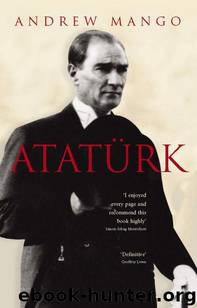Ataturk by Mango Andrew

Author:Mango, Andrew [Mango, Andrew]
Language: zho
Format: epub
Publisher: John Murray
Published: 2011-06-22T16:00:00+00:00
16
Victory in War
IN THE SPRING of 1921, Mustafa Kemal moved out of the stationmaster’s house in Ankara. He had earlier arranged for a more comfortable residence to be built for him not far from the farm school at Keçiören, but a better choice came up. There were pleasant summer houses on the hill of Çankaya, lying in the opposite direction, south-east of the town. The houses had been built among orchards and afforded a good view of the countryside. The air was clean, and the hill position secure. Security was important as bandits were still roaming round the nationalist capital.1 According to one report, Mustafa Kemal’s friend, the journalist Ruşen Eşref (Ünaydın), took Fikriye to the largest house near the top of the hill. She liked it, and Mustafa Kemal approved the choice.2
The house was built of stone, with a garden on two terraces and a fountain.3 It belonged originally to an Armenian, and was then acquired by the local Turkish family of Bulgurzade. The nationalist müftü of Ankara, Rıfat Börekçi, organized a collection to purchase the house, which was then donated to Mustafa Kemal. He, in turn, transferred the title-deeds to the Turkish army, and, as a result, his residence became known as the Army Mansion (Ordu Köşkü).4 Mustafa Kemal’s mementoes – pictures of his mother, photographs showing him in action in Cyrenaica – were displayed on the walls. Photographs of three – and only three – of his supporters, İsmet, Fevzi and Kâzım (Özalp), were later added, and gifts arrived from well-wishers at home and abroad. The style of decoration was Victorian oriental, with arabesque ceilings and decorative braziers for heating, but also a billiard-table and an upright piano.5 Quarters were found near by for Mustafa Kemal’s bodyguard of Laz irregulars – a company of foot soldiers and a company of cavalry.
Mustafa Kemal’s closest friends and collaborators moved into houses lower down the hill. They included childhood friends from Salonica, like his ADC Salih (Bozok) and Lieutenant-Colonel Fuat (Bulca); senior commanders, political supporters (such as interior minister Fethi (Okyar), economy minister Celal (Bayar), the journalist Ruşen Eşref and others. (İsmet was at the front and did not move into his house in Çankaya – the Pink Mansion – until 1925.) Most of the prominent nationalists in Çankaya had their wives with them. The men drank in the evenings as they discussed current developments; the wives kept house. It was a middle-class settlement, with servants and batmen, but no luxuries. Mustafa Kemal had a small generator for his residence. The others made do with paraffin or carbide lamps.6 Although communications were difficult, family members of Çankaya residents travelled to Istanbul and received visitors from the sultan’s capital. It was not an atmosphere conducive to debauch – the charge usually made by Mustafa Kemal’s enemies. Nor was Çankaya an ‘eyrie’, as the nationalist poet Faruk Nafiz (Çamlıbel) described it. But it was removed from the hurly-burly of old Ankara. It was the gathering of an élite which was shaping a new Turkey: there was constant politicking, but no disloyalty to Mustafa Kemal.
Download
This site does not store any files on its server. We only index and link to content provided by other sites. Please contact the content providers to delete copyright contents if any and email us, we'll remove relevant links or contents immediately.
Waking Up in Heaven: A True Story of Brokenness, Heaven, and Life Again by McVea Crystal & Tresniowski Alex(37488)
Empire of the Sikhs by Patwant Singh(22767)
We're Going to Need More Wine by Gabrielle Union(18633)
Hans Sturm: A Soldier's Odyssey on the Eastern Front by Gordon Williamson(18327)
Leonardo da Vinci by Walter Isaacson(12804)
The Radium Girls by Kate Moore(11621)
Tools of Titans by Timothy Ferriss(7815)
Educated by Tara Westover(7690)
How to Be a Bawse: A Guide to Conquering Life by Lilly Singh(7156)
Permanent Record by Edward Snowden(5541)
The Last Black Unicorn by Tiffany Haddish(5414)
The Rise and Fall of Senator Joe McCarthy by James Cross Giblin(5147)
Promise Me, Dad by Joe Biden(4908)
The Wind in My Hair by Masih Alinejad(4843)
The Crown by Robert Lacey(4572)
A Higher Loyalty: Truth, Lies, and Leadership by James Comey(4551)
The Iron Duke by The Iron Duke(4122)
Joan of Arc by Mary Gordon(3782)
Stalin by Stephen Kotkin(3724)
